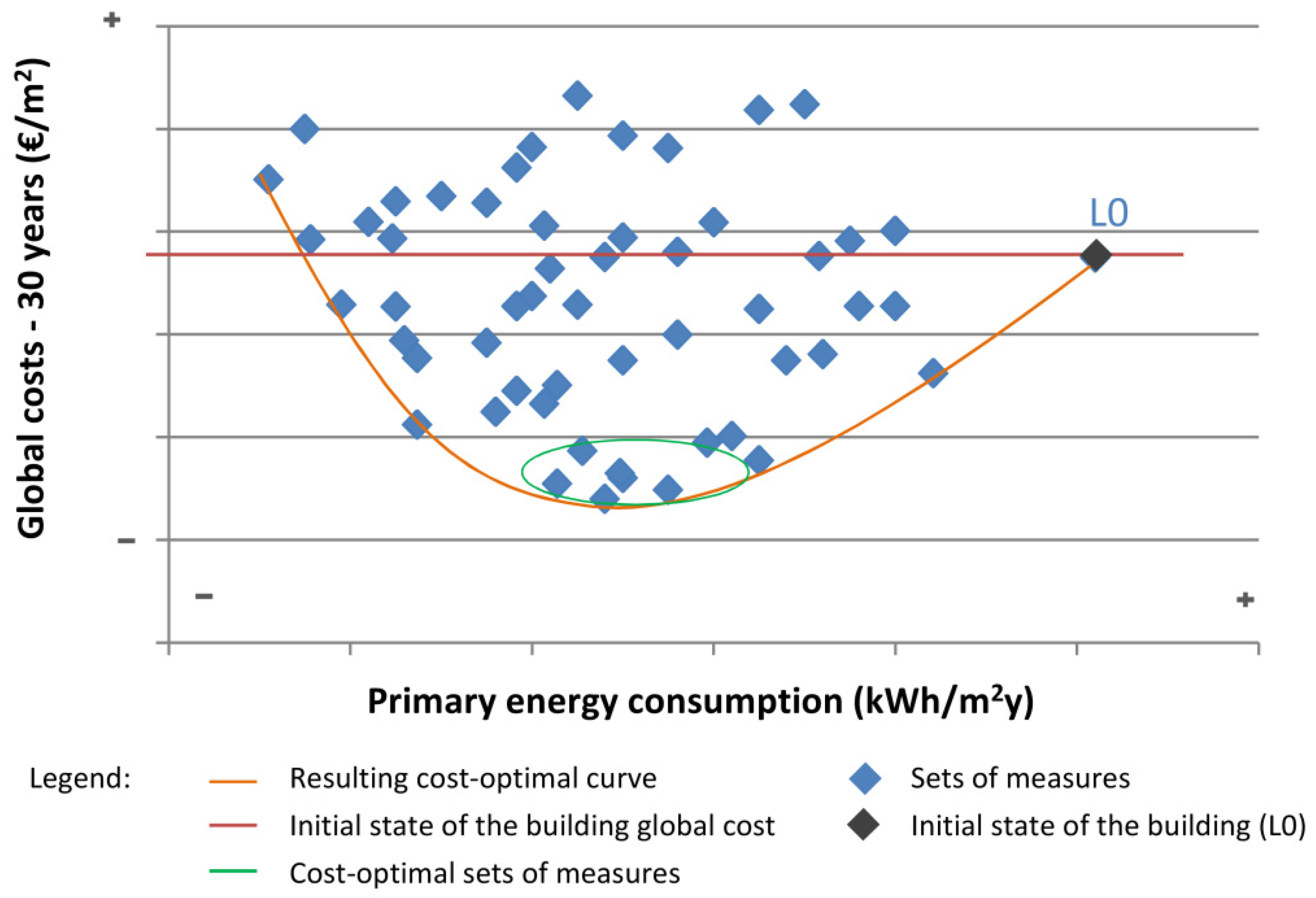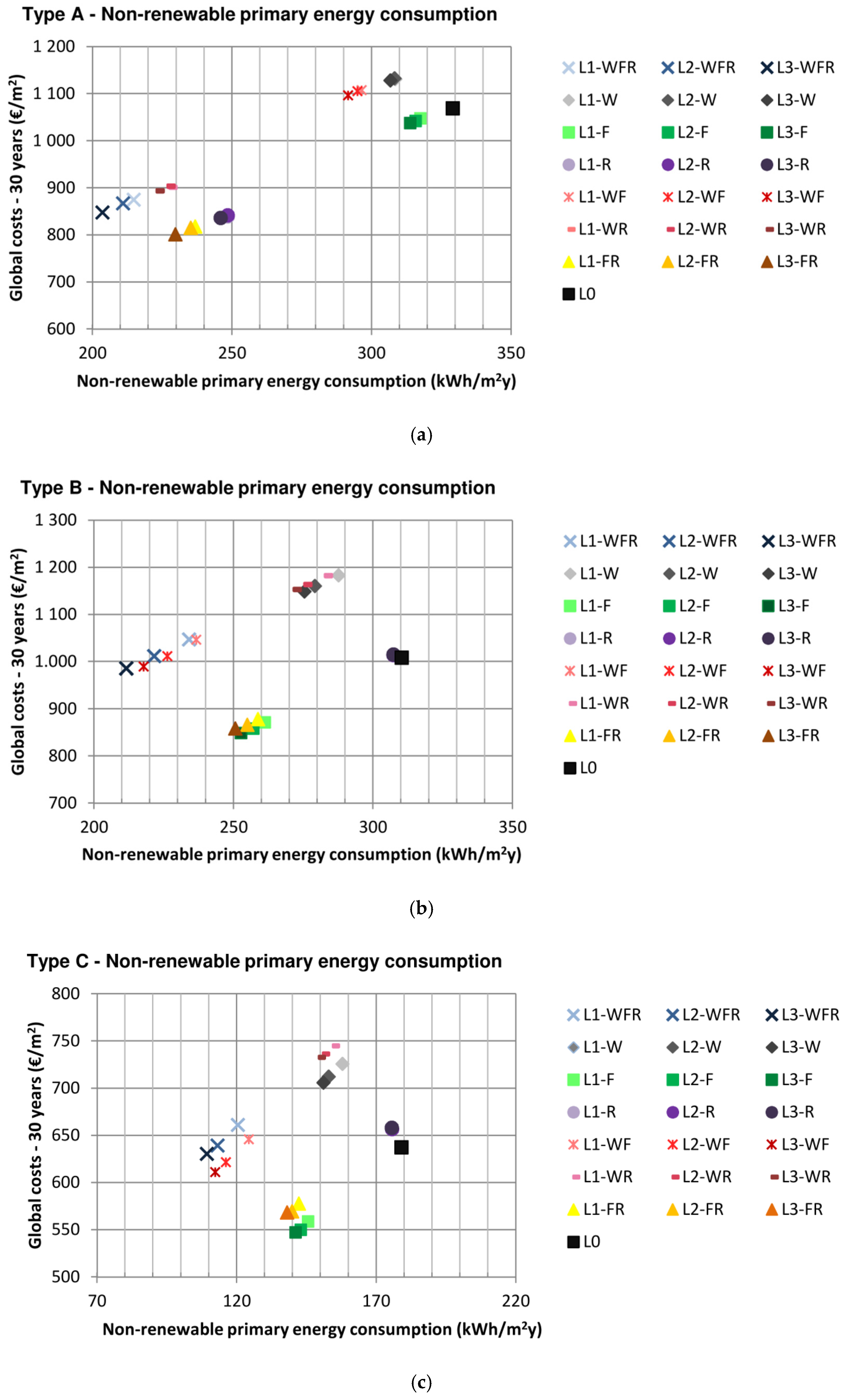Identification of Cost-Optimal Measures for Energy Renovation of Thermal Envelopes in Different Types of Public School Buildings in the City of Valencia
Abstract
:1. Introduction
2. Materials and Methods
2.1. Cost Optimisation Methodology
- Setting representative buildings.
- Identification of energy efficiency measures, as well as improvement measures based on renewable energy sources and/or sets of variants of both types of measures applicable to each reference building.
- Calculation of primary energy demand, resulting from implementing the measures and sets of measures defined for reference buildings.
- Calculation of global cost as annual net value for each reference building.
2.1.1. Buildings under Study
2.1.2. Energy Efficiency Measures and Sets of Measures
2.1.3. Calculation of Global Costs of Sets of Measures
2.2. Implementing Legislation
3. Discussion on Results
3.1. Results on Global Costs of Measures and Primary Energy Consumption
3.2. Regulatory Requirements and Compliance
4. Conclusions
Author Contributions
Funding
Institutional Review Board Statement
Informed Consent Statement
Conflicts of Interest
References
- European Commission Notice, 28 November 2018 (COM/2018/773 final). A Clean Planet for Everyone. Europe’s Long-Term Strategic Vision for a Prosperous, Modern, Competitive and Climate-Neutral Economy. Available online: http://eur-lex.europa.eu (accessed on 1 April 2021).
- Directive 2018/844/EU by the European Parliament and Council, 30 May 2018, Which Modifies Directives 2010/31/EU, on Energy Efficiency of Buildings, and 2012/27/EU, on Energy Efficiency. Available online: http://eur-lex.europa.eu (accessed on 1 April 2021).
- European Commission Notice, 11 December 2019 (COM/2019/640 Final). European Green Pact. Available online: http://eur-lex.europa.eu (accessed on 1 April 2021).
- European Commission Notice, 17 September 2020 (COM/2020/562 Final). Stepping up Europe’s Climate Ambition by 2030: Investing in a Climate-Neutral Future for Citizens’ Benefits. Available online: http://eur-lex.europa.eu (accessed on 1 April 2021).
- EU Countries’ 2018 Cost-Optimal Reports. Available online: https://ec.europa.eu/energy/topics/energy-efficiency (accessed on 1 April 2021).
- Ferrara, M.; Monetti, V.; Fabrizio, E. Cost-Optimal Analysis for Nearly Zero Energy Buildings Design and Optimization: A Critical Review. Energies 2018, 11, 1478. [Google Scholar] [CrossRef] [Green Version]
- Lou, S.; Tsang, E.K.; Li, D.H.; Lee, E.W.; Lam, J.C. Towards zero energy school building designs in Hong Kong. Energy Proceia 2017, 105, 182–187. [Google Scholar] [CrossRef]
- Stocker, E.; Tschurtschenthaler, M.; Shrott, L. Cost-optimal renovation and energy performance: Evidence from existing school buildings in the Alps. Energy Build. 2015, 100, 20–26. [Google Scholar] [CrossRef]
- Dalla Mora, T.; Righi, A.; Peron, F.; Romagnoni, P. Cost-Optimal measures for renovation of existing school buildings towards nZEB. Energy Proceia 2017, 140, 288–302. [Google Scholar] [CrossRef]
- Gaitani, N.; Cases, L.; Mastrapostoli, E.; Eliopoulou, E. Paving the way to nearly zero energy schools in Mediterranean. Energy Proceia 2015, 78, 3348–3353. [Google Scholar] [CrossRef] [Green Version]
- Ferrari, S.; Romeo, C. Retrofitting under protection constraints according to the nearly Zero Energy Building (nZEB) target: The case of an Italian cultural heritage’s school building. Energy Proceia 2017, 140, 495–505. [Google Scholar] [CrossRef]
- Marrone, P.; Gori, P.; Asdrubali, F.; Evangelisti, L.; Calcagnini, L.; Grazieschi, G. Energy Benchmarking in Educational Buildings through Cluster Analysis of Energy Retrofitting. Energies 2018, 11, 649. [Google Scholar] [CrossRef] [Green Version]
- Mora, T.D.; Pinamonti, M.; Teso, L.; Boscato, G.; Peron, F.; Romagnoni, P. Renovation of a School Building: Energy Retrofit and Seismic Upgrade in a School Building in Motta Di Livenza. Sustainability 2018, 10, 969. [Google Scholar] [CrossRef] [Green Version]
- European Project “Sherpa” (Shared Knowledge for Energy Renovation in Buildings by Public Administrations); Technical Report, EU Project Financed by the Interreg Med Programme (2017–2019); Available online: https://sherpa.interreg-med.eu/ (accessed on 1 April 2021).
- Soto, V.M.; Serrano, B.; Valero, V.; Navarro, M. Improving schools performance based on SHERPA project outcomes: Valencia case (Spain). Energy Build. 2020, 225, 110297. [Google Scholar] [CrossRef]
- Jradi, M. Dynamic Energy Modeling as an Alternative Approach for Reducing Performance Gaps in Retrofitted Schools in Denmark. Appl. Sci. 2020, 10, 7862. [Google Scholar] [CrossRef]
- Arambula Lara, R.; Pernigotto, G.; Cappelletti, F.; Romagnoni, P.; Gasparella, A. Energy audit of schools by means of cluster analysis. Energy Build. 2015, 95, 160–171. [Google Scholar] [CrossRef]
- Dimoudi, A.; Kostarela, P. Energy monitoring and conservation potential in school buildings in the C ′Climatic zone of Greece. Renew. Energy 2009, 34, 289–296. [Google Scholar] [CrossRef]
- Santoli, L.; Fraticelli, F.; Fornari, F.; Calice, C. Energy performance assessment and retrofit strategies in public school buildings in Rome. Energy Build. 2014, 68, 196–202. [Google Scholar] [CrossRef]
- Katafygiotou, M.; Serghides, D. Analysis of structural elements and energy consumption of school building stock in Cyprus: Energy simulations and upgrade scenarios of a typical school. Energy Build. 2014, 72, 8–16. [Google Scholar] [CrossRef]
- Vázquez, C.; Manuel, J. La Rehabilitación Energética en la Arquitectura Escolar. Hacia el Edificio Rehabilitado nZEB. (Energy Renovation in School Building Architecture. Towards the Renovated Building nZEB). Ph.D. Thesis, University of La Coruña, La Coruña, Spain, 2017. [Google Scholar]
- Website of the Technical Building Code. CTE DB HE 2019_ Real Decreto 732/2019, de 20 de Diciembre, por el que se Modifica el Código Técnico de la Edificación, Aprobado por el Real Decreto 314/2006, de 17 de Marzo. (CTE DB HE 2019_ Royal Decree 732/2019, 20 December, Which Modifies the Technical Building Code, Approved by Royal Decree 314/17 March 2006). Available online: https://www.codigotecnico.org/pdf/Documentos/HE/DBHE.pdf (accessed on 1 April 2021).
- Directive 2010/31/EU of the European Parliament and the Council, 19 May 2010 on Energy Efficiency of Buildings (Recast). Available online: http://eur-lex.europa.eu (accessed on 1 April 2021).
- Commission Delegated Regulation (EU) No. 244/2012, 16 January 2012, Which Complements Directive 2010/31/EU of the European Parliament and the Council, on the Energy Efficiency of Buildings, Establishing a Comparative Methodological Framework to Calculate Optimal Levels of Profitability of the Minimum Requirements for Energy Efficiency of Buildings and Their Elements and Accompanying Guidelines. Available online: https://eur-lex.europa.eu (accessed on 1 April 2021).
- Website of the Technical Building Code. CTE DB HE 2006_Royal Decree 314/2006, 17 March, Approving the Technical Building Code. Available online: https://www.codigotecnico.org/pdf/Documentos/HE/DBAnteriores/DBHE_200602.pdf (accessed on 1 April 2021).




| Thermal Envelope Element | Type A | Type B | Type C |
|---|---|---|---|
| Construction date | 1947 | 1957 | 1975 |
| Constructed area | 1634.77 m2 | 1002.70 m2 | 2595 m2 |
| Living area | 785.89 m2 | 525.42 m2 | 1993.27 m2 |
| Number of floors | 2 | 3/4 | 2 |
| Climate zone | B3/IV | B3/IV | B3/IV |
| Use | 8 h | 8 h | 8 h |
| Roofs | Curved ceramic roof tiles over ceramic brick board, wooden structure, highly ventilated air chamber, false ceiling made of cane, plaster. | Ceramic tiles, mortar, ceramic brick boards, waterproof protection, horizontal air chamber, reinforced with concrete slab floor, plaster. | Ceramic tiles, mortar, waterproof protection, reinforced with concrete slab floor, plaster. |
| Facades | Rendering mortar, brick wall (thickness: 40 cm/50 cm), plaster. | Rendering mortar, double perforated brick wall with a vertical air chamber (11 + 5 + 4 cm), plaster. | Double perforated brick wall with a vertical air chamber (11 + 7 + 7 cm), plaster. |
| Windows and doors | Wooden windows and metal single-glazed doors | Wooden windows and metal single-glazed doors | Metal single-glazed windows and doors. Rolling shutter |
| Heating System | Electric radiator/s in each room | Electric radiator/s in each room | Central heating through diesel oil boiler with multiple water circulation pumps and iron radiator/s in each room |
| Hot Water System | Electric hot water boiler for kitchen and pre-school toilets | Electric hot water boiler for kitchen and pre-school toilets | Electric hot water boiler for kitchen and pre-school toilets |
| Thermal Envelope Element | Type A | Type B | Type C |
|---|---|---|---|
| Facades | 1.1/0.92 | 2.94/1.33 | 1.41/1.29 |
| Roofs | 4.17 | 2.33/1.79 | 1.79 |
| Windows (single glazed/structure) | 5.7/2.2 | 5.7/2.2 | 5.7/5.7 |
| Thermal Envelope Element | L1 1 | L2 2 | L3 3 |
|---|---|---|---|
| Facades | 0.82 | 0.56 | 0.38 |
| Roofs | 0.45 | 0.44 | 0.33 |
| Windows | 3.3 | 2.3 | 2 |
| Thermal Envelope Element | L1 | L2 | L3 |
|---|---|---|---|
| Windows (W) | L1 W | L2 W | L3 W |
| Facades (F) | L1 F | L2 F | L3 F |
| Roofs (R) | L1 R | L2 R | L3 R |
| Windows + Facades (WF) | L1 WF | L2 WF | L3 WF |
| Windows + Roofs (WR) | L1 WR | L2 WR | L3 WR |
| Facades + Roofs (FR) | L1 FR | L2 FR | L3 FR |
| Windows + Facades + Roofs (WFR) | L1 WFR | L2 WFR | L3 WFR |
| Type of School Building | L0 | Elements Improved | L1 | L2 | L3 |
|---|---|---|---|---|---|
| Type A | €1069.29 | R | €840 | €842 | €836 |
| FR | €818 | €815 | €802 | ||
| WR | €901 | €904 | €894 | ||
| WFR | €875 | €868 | €848 | ||
| Type B | €1008.40 | F | €871 | €858 | €849 |
| FR | €879 | €866 | €859 | ||
| WF | €1047 | €1012 | €990 | ||
| WFR | €1047 | €1012 | €986 | ||
| Type C | €637.46 | F | €559 | €533 | €547 |
| FR | €578 | €570 | €568 | ||
| WF | €646 | €622 | €611 | ||
| WFR | €661 | €639 | €631 |
| Type of School Building | Elements Improved | L1 | L2 | L3 |
|---|---|---|---|---|
| Type A | R | 10,766.4 | 10,766.4 | 11,080.8 |
| FR | 12,338.2 | 12,573.9 | 13,281.2 | |
| WR | 13,517.0 | 13,595.6 | 14,145.7 | |
| WFR | 15,245.9 | 15,796.0 | 16,739.0 | |
| Type B | F | 4413.5 | 4781.3 | 5149.1 |
| FR | 4623.7 | 4938.9 | 5306.7 | |
| WF | 6410.1 | 7513.5 | 8249.1 | |
| WFR | 6830.5 | 7933.8 | 8827.1 | |
| Type C | F | 17,740.1 | 19,135.4 | 20,132.0 |
| FR | 19,534.0 | 20,730.0 | 21,726.6 | |
| WF | 28,503.8 | 32,291.0 | 34,483.6 | |
| WFR | 31,095.0 | 34,682.9 | 36,875.5 |
| Type of School Building | Elements Improved | L1 | L2 | L3 |
|---|---|---|---|---|
| Type A | R | €6868.81 | €6868.81 | €7078.37 |
| FR | €7858.39 | €7991.44 | €8458.78 | |
| WR | €8630.09 | €8693.29 | €9022.59 | |
| WFR | €9732.76 | €10,057.07 | €10,684.08 | |
| Type B | F | €2799.90 | €3032.30 | €3284.72 |
| FR | €2936.67 | €3153.51 | €3399.25 | |
| WF | €4080.88 | €4784.74 | €5266.22 | |
| WFR | €4343.30 | €5053.84 | €5624.27 | |
| Type C | F | €8297.11 | €8954.29 | €9410.83 |
| FR | €9133.15 | €9741.87 | €10,192.79 | |
| WF | €13,510.74 | €15,446.24 | €16,439.34 | |
| WFR | €14,599.98 | €16,362.83 | €17,343.28 |
| % Reduction in Energy Consumption | Amortisation of Investment (Years) | ||||||
| Type of School Building | Elements Improved | L1 | L2 | L3 | L1 | L2 | L3 |
| Type A | R | 24.5% | 24.5% | 25.3% | 4 | 5 | 5 |
| FR | 28.1% | 28.5% | 30.2% | 5 | 6 | 6 | |
| WR | 30.8% | 31.0% | 32.2% | 15 | 15 | 15 | |
| WFR | 34.8% | 35.9% | 38.1% | 14 | 14 | 14 | |
| Type B | F | 15.8% | 17.1% | 18.6% | 5 | 4 | 5 |
| FR | 16.6% | 17.8% | 19.2% | 7 | 7 | 7 | |
| WF | 23.1% | 27.1% | 29.8% | >30 | >30 | 29 | |
| WFR | 24.6% | 28.6% | 31.8% | >30 | >30 | 29 | |
| Type C | F | 18.6% | 20.1% | 21.1% | 13 | 12 | 13 |
| FR | 20.5% | 21.9% | 22.9% | 19 | 19 | 19 | |
| WF | 30.5% | 35.1% | 27.3% | >30 | 29 | 28 | |
| WFR | 32.8% | 36.8% | 38.9% | >30 | >30 | 30 | |
| K (W/m²K) | |||||
| Type of School Building | Klim | Elements Improved | L1 | L2 | L3 |
| Type A | 0.9 | R | 2.83 | 2.83 | 2.83 |
| FR | 2.25 | 2.07 | 1.91 | ||
| WR | 2.44 | 2.19 | 2.13 | ||
| WFR | 1.86 | 1.43 | 1.21 | ||
| Type B | 0.85 | F | 2.27 | 2.18 | 2.09 |
| FR | 1.94 | 1.84 | 1.73 | ||
| WF | 1.90 | 1.62 | 1.46 | ||
| WFR | 1.57 | 1.29 | 1.11 | ||
| Type C | 0.86 | F | 2.31 | 2.21 | 2.14 |
| FR | 1.72 | 1.62 | 1.42 | ||
| WF | 1.82 | 1.54 | 1.50 | ||
| WFR | 1.23 | 0.95 | 0.78 | ||
Publisher’s Note: MDPI stays neutral with regard to jurisdictional claims in published maps and institutional affiliations. |
© 2021 by the authors. Licensee MDPI, Basel, Switzerland. This article is an open access article distributed under the terms and conditions of the Creative Commons Attribution (CC BY) license (https://creativecommons.org/licenses/by/4.0/).
Share and Cite
Liébana-Durán, M.E.; Serrano-Lanzarote, B.; Ortega-Madrigal, L. Identification of Cost-Optimal Measures for Energy Renovation of Thermal Envelopes in Different Types of Public School Buildings in the City of Valencia. Appl. Sci. 2021, 11, 5108. https://doi.org/10.3390/app11115108
Liébana-Durán ME, Serrano-Lanzarote B, Ortega-Madrigal L. Identification of Cost-Optimal Measures for Energy Renovation of Thermal Envelopes in Different Types of Public School Buildings in the City of Valencia. Applied Sciences. 2021; 11(11):5108. https://doi.org/10.3390/app11115108
Chicago/Turabian StyleLiébana-Durán, María Esther, Begoña Serrano-Lanzarote, and Leticia Ortega-Madrigal. 2021. "Identification of Cost-Optimal Measures for Energy Renovation of Thermal Envelopes in Different Types of Public School Buildings in the City of Valencia" Applied Sciences 11, no. 11: 5108. https://doi.org/10.3390/app11115108






